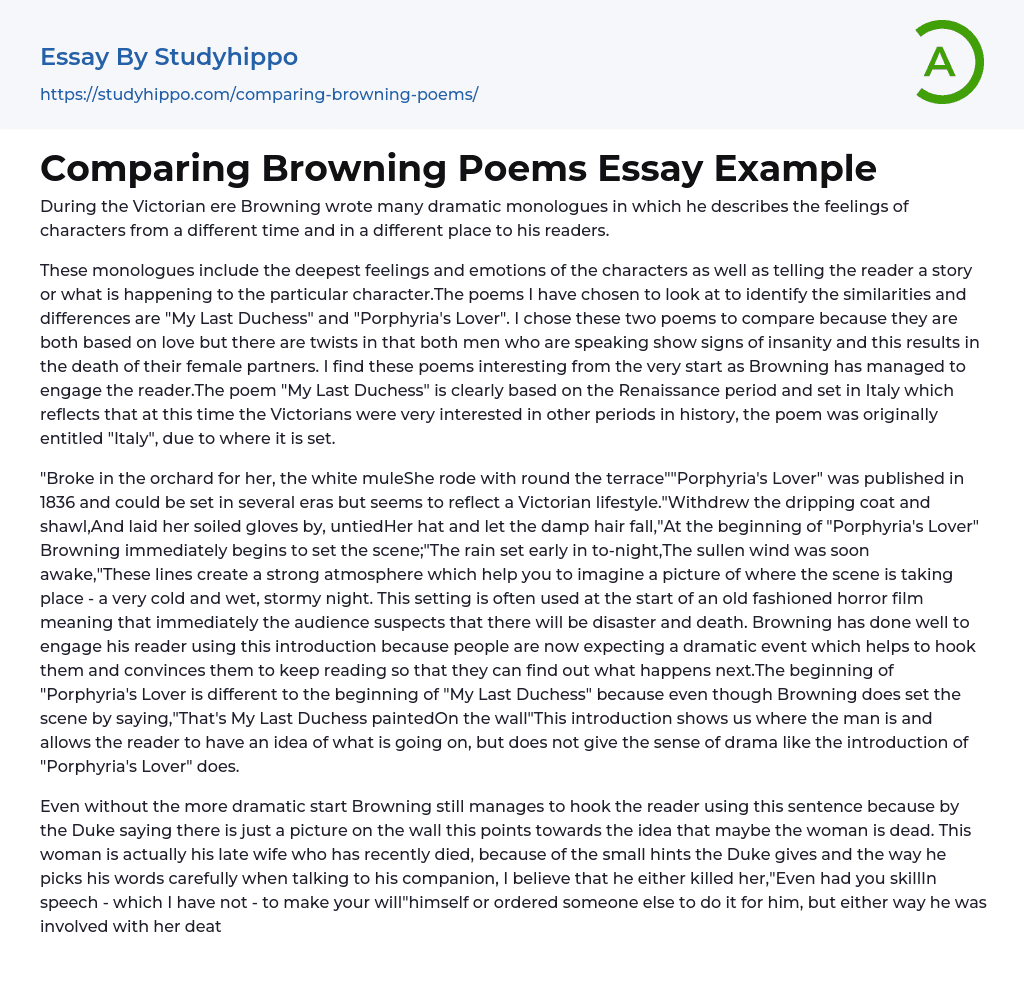Throughout the Victorian period, Browning crafted dramatic monologues that allowed his readers to empathize with characters from distant times and places.
In this passage, the author discusses how monologues can express the deepest emotions of characters while also telling a story. They compare two poems, "My Last Duchess" and "Porphyria's Lover," because they both deal with love and involve insane male speakers causing the death of their female partners. The author finds the poems engaging and notes that "My Last Duchess" is set in Italy during the Renaissance period, which reflects Victorian interests in historical periods. Originally titled "Italy," the poem reflects its setting.
Browning's "Porphyria's Lover" was published in 1836 and presents a scene that could belong to different eras, yet reflects a Victorian lifestyle. The poem starts with the protagon
...ist describing the weather conditions as "The rain set early in tonight, The sullen wind was soon awake," creating an atmosphere of a cold and wet, stormy night. This setting is often seen in old fashioned horror films, hinting at potential tragedy and death. By introducing the setting in this way, Browning engages the reader and encourages them to continue reading to uncover what happens next. In contrast, "My Last Duchess" reveals where the man is but lacks the same sense of drama as "Porphyria's Lover".
Despite lacking a dramatic start, Browning still captivates the reader through the Duke's statement that a picture on the wall is all that remains, hinting at the possibility of the woman's death. The woman in question is actually the Duke's deceased wife, as evidenced by his careful choice of words and subtle insinuations. It is believed that he may have been
involved in her demise, whether by committing the act himself or hiring someone else, due to his perception of her flirtatious nature. The reader is compelled to continue reading in search of the truth, having assumed the Duke's guilt. Both poems share similar themes, with the male protagonists deeply in love with their female counterparts and consumed by jealousy, desiring complete possession of them.
Both men in the texts are willing to murder those they love to prevent them from being with anyone else. The man in "Porphyria's Lover" demonstrates this by using her own hair to strangle her. "In one long yellow string I wound/ Three times her little throat around/ And strangled her." This quote, which features enjambment, rhyming and adjectives, also has a strong rhythm with each line containing eight syllables.
The poem presents a calm and straightforward narrative style, conveyed through Browning's use of language. Throughout the text, quotes suggest that the murderer does not view their actions as wrong, indicating possible mental instability and prior violent behavior. Browning's deliberate character development makes for a captivating read as the full extent of the character's insanity is revealed.
The man's mental problems are evident through his possessive thoughts towards Porphyria, viewing her as his own property to control. He states, "That moment she was mine, mine." After murdering Porphyria, he further displays his insanity by clinging to her body and waiting for divine punishment, exclaiming, "And all night long we have not stirred, And yet God has not said a word!" Browning's use of rhyming couplets in this quote highlights the character's disturbed thinking, suggesting he believes himself to be on par with
a god. Despite receiving no punishment, the man believes he was justified in his actions and desires to keep Porphyria forever.
The Duke's desire to control his wife and treat her like a possession is similar to the behavior depicted in "My Last Duchess." Even after the wife's death, the Duke behaves as if he is guarding her painting. Browning skillfully hooks the reader by implying that the Duchess may have been unfaithful to her husband. The Duke is proud to have had his wife and even shows her off to the passing public like some sort of possession, saying "Will't please you sit and look at her." This line invites the reader into the story but is actually directed towards the father of his new wife. Throughout "My Last Duchess," Browning directs many questions at the ambassador that can appear aimed at the reader, such as "Who'd stoop to blame/Thus sort of trifling?" and "but who passed without/Much the same smile?" These examples use enjambment to create a flowing effect, allowing sentences to flow from one line to another.
Although "Porphyria's Lover" lacks any questions and is structured more as a narrative, it differs from "My Last Duchess" by creating a greater sense of involvement for the reader.
- Nightclub essays
- Book Summary essays
- Metaphor essays
- Reader essays
- Rhyme essays
- Literary devices essays
- Villain essays
- Books essays
- Genre essays
- Literary Criticism essays
- Writer essays
- Protagonist essays
- Simile essays
- Poem essays
- Book Report essays
- Book Review essays
- Greek Mythology essays
- Plot essays
- Tragic Hero essays
- Coming of Age essays
- Play essays
- Rhetoric essays
- Rhetorical Question essays
- Translation essays
- Understanding essays
- Reason essays
- Character essays
- Letter essays
- American Literature essays
- Literature Review essays
- Utopia essays
- Poetry Analysis essays
- Dante's Inferno essays
- Between The World and Me essays
- Incidents in The Life of a Slave Girl essays
- Flowers for Algernon essays
- Myth essays
- Everyday Use essays
- Boo Radley essays
- Genesis essays
- Richard iii essays
- Alice in Wonderland essays
- On the road essays
- Ozymandias essays
- The Nightingale essays
- Holden Caulfield essays
- Animal Farm essays
- 1984 essays
- A Hanging essays
- Shooting An Elephant essays




